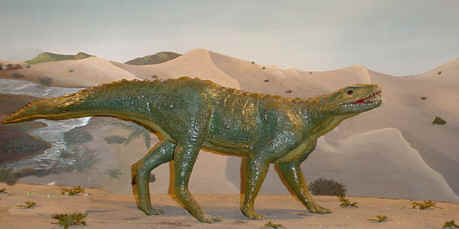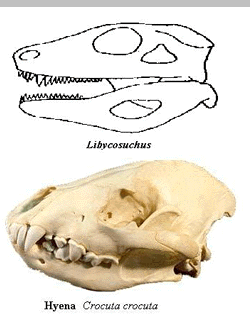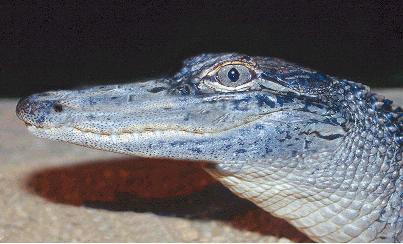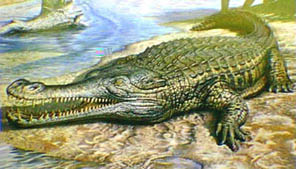 Metasuchia: Notosuchus + Crocodylus [S+01].
Metasuchia: Notosuchus + Crocodylus [S+01].| Crocodilia/ Crocodylomorpha |
||
| The Vertebrates | Metasuchia |
| Vertebrates Home | Vertebrate | Vertebrate |
Abbreviated Dendrogram
Archosauria
│
└─Crocodylomorpha
├─Sphenosuchia
└─Crocodyliformes
├─Protosuchia
└─Mesoeucrocodylia
├─Thalattosuchia
└─Metasuchia
├─Notosuchidae
├─┬─Baurusuchidae
│ └─Libycosuchidae
└─┬─Sebecosuchidae
└─Neosuchia
├─┬─Dyrosauridae
│ └─┬─Terminonaris
│ └─Sarcosuchus
└─Crocodylia
├─Gavialidae
└─┬─Alligatoridae
└─Crocodylidae |
Contents
Index |
Not a great deal is known about the Sebecosuchidae. Indeed, the post-cranial skeleton is completely unknown. A few isolated vertebrae and osteoscutes have been found in association with Sebecosuchid remains. However, characterizing these fossils as Sebecosuchid is hazardous.
As a result, there is some controversy about the ecological place of these animals. Traditionally, it was supposed that the Sebecosuchids occupied a transitional top-predator niche after the extinction of the dinosaurs and before the arrival of carnivorous placental mammals in South America. This theory seems to have fallen into disfavor for two reasons. First, the Sebecosuchids disappeared a bit too early -- around the mid- to late Miocene, before placentals really got going in South America. Second, Sebecosuchids are almost always recovered from environments that were river and lake deposits in tropical forests: that is, jungle areas like the Amazon Basin today. This had led to speculation that they were semi-aquatic riparian predators like living Crocodilians.
However, Busbey (1986) points out that, even if this were the case, the Sebecosuchids cannot have hunted in the same manner that crocs do today. Modern crocs latch on to large prey and roll with it into the water, both to kill and to disarticulate. Sebecosuchids, with their long, thin, but very tall, rostrum, would be far less suited for this strategy. See also: Holtz 1997). Further, their jaw is specialized to maximize the strength of the jaw-opening muscles and the teeth are very similar to Theropod teeth, designed for slicing and tearing rather than as holdfasts. Busbey notes that the structure of the jaw is similar to Varanidae -- terrestrial ambush predators. However, this does not explain their distribution, nor the laterally thin, almost pisciverous, jaw.
Unfortunately, there is little good Sebecosuchid material. For this reason, it is entirely possible that the association with aquatic deposits is simply a taphonomic artifact. However, even it reflects an actual ecological association, the narrowness of the jaw may simply reflect the optimal mechanics for specialized prey: perhaps flightless birds. One could imagine, for example, Sebecus as a moderately long-legged ambush predator feeding on flightless or nearly flightless wading birds. It springs or rushes out of ambush, opening its jaws quickly and allowing them to slam together hard enough to snap the relatively fragile tibiotarsus of the bird. Unlike mammalian prey, this immediately immobilizes the victim, making a rolling, aquatic attack unnecessary.
 Metasuchia: Notosuchus + Crocodylus [S+01].
Metasuchia: Notosuchus + Crocodylus [S+01].
Range: from the Early Cretaceous
Phylogeny: Mesoeucrocodylia: Thalatosuchia+ * : Notosuchidae+ (Baurusuchidae+ Libycosuchidae) + (Sebecosuchidae + Neosuchia)
Characters: Small or moderate body size [S+01].
Image: Notosuchus from www.neuquentur.gov.ar - default
Links: Metasuchia after Sereno, Larsson, Sidor & Gado, 2001.
References: Sereno et al. (2001) [S+01].
Notosuchidae: Notosuchus.
upK of SAm.
Metasuchia : (Baurusuchidae + Libycosuchidae) + (Sebecosuchidae + Neosuchia) + *.
Baurusuchidae: Baurusuchus.
Late Cretaceous, possibly surviving to Eocene, of South America & Europe.
Metasuchia :: Libycosuchidae + *.
Therapsid-like dog-sized terrestrial forms.
Links: reptiles; トミーの進化論 in どうぶつ大百科; Re- New Mesozoic vertebrate articles. ATW030601.
 Libycosuchidae: Libycosuchus.
Libycosuchidae: Libycosuchus.
lwK-upK of Afr.
Metasuchia :: Baurusuchidae + *.
Small (~1 m) terrestrial croc, with very strong jaw muscles. Very short, rather tall rostrum (shorter than post-orbital region); diastema absent; deep lower jaw; large pterygoid "wings" (related to adductor muscle development); $ maxillae excluded from margins of pterygoid vacuities by palatine and "transverses" (= ectopterygoids?); choanae have been variously placed and actual position unknown; nares placed laterally on rostrum; orbits large; antorbital fenestra present only as unperforated depression; very large mandibular fenestra; sharp angle between dorsal and posterior "ventral"?!) faces of the occiput (i.e. a very sharp or abrupt angle between the top & back of the head); quadrate strongly curved, with large ventral process, displacing jaw articulation anteriorly; post-cranial skeleton known only from fragments.
Links: Buffetaut, E.
Image: The comparison with hyena skulls is instructive. Lycaon sp. Hyena Skull from Skulls Unlimited; Image of L. from Buffetaut (1982); Hyena skull © 1998 Kronen Osteo, by permission.
Note: As Buffetaut (1982) points out, the skull shows numerous adaptations for an exceedingly strong & fast bite.
 Sebecosuchidae:
Sebecus, Ayllusuchus.
Sebecosuchidae:
Sebecus, Ayllusuchus.
Pc-Mc of SAm, Eur? Afr?.
Metasuchia ::: Neosuchia + *.
Active terrestrial predators. Tall, narrow rostrum; sides of rostrum tall and nearly vertical; teeth long, curved, laterally compressed and se (very similar to theropod teeth); 4 teeth on premaxilla; 10-11 teeth on maxilla; no enlarged maxillary teeth; teeth widely spaced, intercalate; posterior ends of maxillae meet on palate anterior to palatine; broad maxilla forms sides of rostrum, and narials forms flat dorsal portion, terminating in a premaxilla with substantial diastema; maxilla and premaxilla do not overlap; no maxillary fenestra; nares face antero-laterally or dorso-laterally; maxilla and, especially, premaxilla deeply sculptured with deep pits connected by channels; rostrum widens abruptly in front of orbits; orbit relatively small; angular and surangular large, long and strongly curved dorsally; axial skeleton largely unknown.
References: Busbey 1986); Gasparini 1984).
Image: life reconstruction of a juvenile Sebecus altered from an image of Alligator © John White with permission.
Range: fr lwK.
Phylogeny: Metasuchia::: Sebecosuchidae + * : Crocodylia+ (Dyrosauridae+ (Terminonaris+ Sarcosuchus)).
 Dyrosauridae: Atlantosuchus, Dyrosaurus, Hyposaurus, Phosphatosaurus, Rhabdognathus, Sokotosuchus, Tilemsisuchus.
Dyrosauridae: Atlantosuchus, Dyrosaurus, Hyposaurus, Phosphatosaurus, Rhabdognathus, Sokotosuchus, Tilemsisuchus.
Range: Late Cretaceous (Maastrichtian) to Early Eocene worldwide.
Neosuchia :: (Terminonaris + Sarcosuchus) + *.
~4m longirostrine forms; external mandibular fenestra reduced; tall neural spines; lateral area of tail expanded by elongated chevrons; appendicular skeleton not reduced; limbs relatively long (~1.5 - 2 times longer than in the image); limbs subequal, with no polydactyly or hyperphalangy; osteoderms reduced; strong swimmers & possibly walkers with lightly built snout, favoring shallow marine and some freshwater habitats.
Links: Treasures of the Earth Ltd. Dyrosaurus; AMBAR; Ablauf der Evolution: Mesozoikum; Kreide (German); Re: K/T impact.
References: Hua & Buffetaut (1997). ATW021015.
Terminonaris: T. browni Osborn, 1904; T. robusta Mook, 1934.
Range: mK of NAm.
Phylogeny: Neosuchia ::: Sarcosuchus + *.
Links: An abstract of a paper supporting our phylogenetic placement can be found at Terminonaris. Very recent finds confirm the placement, as stated at Crocs in CJES. Other DML entries also touch on some anatomical aspects of the genus. See New in Palaeontology, 48, 2 and Re- Gnathosaurus question. German summaries of some of the most recent work can be found at Literaturbericht. We have not been able to locate any other worthwhile links on Terminonaris. However, the many links relating to Sarchosuchus compare the two, closely-related forms.
Note: for list of characters uniting Terminonaris with Sarcosuchus, see Sarcosuchus.
Sereno et al. (2001), X-C Wu, AP Russell & SL Cumbaa (2001), J. Vert Paleontol. 21: 492.
011128. ATW050804.
Range: middle Cretaceous of Africa (Niger)
Phylogeny: Neosuchia ::: Terminonaris + *.
Characters: Up to 11m & 8000 kg; snout 75% of skull length, very long but much wider than usual longirostrine forms; premaxilla form expanded bulla around undivided nares; large choanae separated by narrow pterygoid septum; choanae bordered by palatines & pterygoids; 5 premaxillary, 30 maxillary, 31 dentary teeth; premaxilla 3-4, maxilla 10 & dentary 3-4 enlarged; teeth stout, conical, sharp-pointed, with small anterior & posterior keels; all dentary teeth occlude inside maxillary toothrow; dentary also 10 cm shorter than maxilla; large diastema; no teeth insert into diastema; no maxillary fossae; very long, narrow anterior rami of nasals remains in medial contact with premaxillae; orbits dorsal & moderately telescoped; trapezoidal supratemporal fossa slightly larger than orbit; cervical vertebrae with shallow ventral keel and overlapping cervical ribs; all vertebrae amphicoelous; dorsal vertebrae with long transverse processes & short, stout neural spines; scapulae, coracoids & pubes flare widely & sacrum provides very broad dorsal surface; continuous, broad line of osteoscutes from neck to tail; immature specimens appear conventionally longirostrine, & snout broadens late in development; generalized fresh water ambush predator.
Note: Synapomorphies of unnamed Sarcosuchus + Terminonaris clade per [S+01]: premaxillary palate with circular paramedian depressions; premaxillary teeth and alveolar margin angled postreoventrally; premaxillary tooth row angled posterolaterally; last pmx tooth lateral to 1st mx tooth; premaxillary toothrow ventrally offset; distal dentary transversely expanded. Now that's interesting! Almost all the characters joining the two species are, according to Sereno's work, features acquired by Sarcosuchus individuals late in ontogeny. This decoupling of dentary and maxillary development might require some significant genetic novelties. See Meckel's Cartilage.
Links: National Geographic SuperCroc--Sarcosuchus imperator, photos, maps, bios, tour information; African Fossil Find: 40-Foot Crocodile (washingtonpost.com); Geological Society - News - Giant croc and a right load of bulla; RP-Online - Wissenschaft (German); Untitled Document. Too many good sites to list them all.
Sereno et al. (2001) [S+01].
ATW030803
checked ATW050804